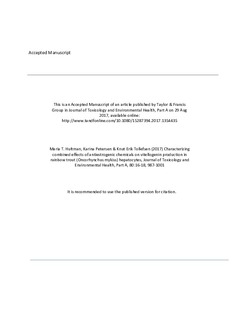| dc.contributor.author | Hultman, Maria Thérése | |
| dc.contributor.author | Petersen, Karina | |
| dc.contributor.author | Tollefsen, Knut Erik | |
| dc.date.accessioned | 2018-11-13T07:47:12Z | |
| dc.date.available | 2018-11-13T07:47:12Z | |
| dc.date.created | 2017-12-27T18:26:20Z | |
| dc.date.issued | 2017 | |
| dc.identifier.citation | Journal of Toxicology and Environmental Health, Part A. 2017, 80 (16-18), 987-1001. | nb_NO |
| dc.identifier.issn | 1528-7394 | |
| dc.identifier.uri | http://hdl.handle.net/11250/2572074 | |
| dc.description.abstract | Fish are exposed to a complex mixture of endocrine disrupting compounds (EDC), some of which display antiestrogenic activity leading to suppression of estrogen receptor (ER)- mediated reproductive processes. Although the main mode of action (MoA) of these antiestrogens is to directly interfere with natural ligand binding of the ER, several other MoA have been proposed. The aim of the present study was to characterize single and combined antiestrogenic effects of the aryl hydrocarbon receptor (AhR)-agonist β-naphthoflavone (BNF) and ER-antagonist 4-hydroxytamoxifen (OHT) on vitellogenin (Vtg) protein using primary rainbow trout (Oncorhynchus mykiss) hepatocytes. Supporting transcriptional analysis of ER-responsive genes (estrogen receptor-α (er-α), vitellogenin-1 (vtg-1), eggshell zona radiata protein (zrp)) and AhR-mediated genes (aryl hydrocarbon receptor-2β, cytochrome p450-1a (cyp1a)) was performed by qPCR to characterize the antiestrogenic influence on ER- and AhR-mediated responses. Data demonstrated that both BNF and OHT significantly reduced 17β-estradiol (E2)-induced Vtg protein expression in a concentration responsive manner, whereas exposure to a mixture of these produced an additive antiestrogenic effect. The results observed at the protein level were further supported by transcriptional analysis of ER-responsive genes (er-α, vtg-1, zrp), where only E2-induced vtg-1 gene expression was significantly decreased by OHT and the mixture of OHT and BNF. E2-induced er-α and zrp gene expression was not markedly altered. The significant reduction of E2-induced vtg-1 gene expression by OHT suggested that the antiestrogenic effect of this compound may be associated with ER signaling pathway. Specific genes involved in putative AhR-ER cross-talk were also investigated, however none were directly associated with the compound anti-estrogenic MoA. Although the MoA of the single compounds and mixture were not completely characterized, the present study enhanced our knowledge of the combined toxicity mediated by antiestrogens acting through different MoA. | nb_NO |
| dc.language.iso | eng | nb_NO |
| dc.publisher | Taylor & Francis | nb_NO |
| dc.title | Characterizing combined effects of antiestrogenic chemicals on vitellogenin production in rainbow trout (Oncorhynchus mykiss) hepatocytes | nb_NO |
| dc.title.alternative | Characterizing combined effects of antiestrogenic chemicals on vitellogenin production in rainbow trout (Oncorhynchus mykiss) hepatocytes | nb_NO |
| dc.type | Journal article | nb_NO |
| dc.type | Peer reviewed | nb_NO |
| dc.description.version | acceptedVersion | nb_NO |
| dc.source.pagenumber | 987-1001 | nb_NO |
| dc.source.volume | 80 | nb_NO |
| dc.source.journal | Journal of Toxicology and Environmental Health, Part A | nb_NO |
| dc.source.issue | 16-18 | nb_NO |
| dc.identifier.doi | 10.1080/15287394.2017.1354435 | |
| dc.identifier.cristin | 1532239 | |
| dc.relation.project | Norges forskningsråd: 196318 | nb_NO |
| cristin.unitcode | 7464,20,13,0 | |
| cristin.unitname | Økotoksikologi | |
| cristin.ispublished | true | |
| cristin.fulltext | postprint | |
| cristin.qualitycode | 1 | |
